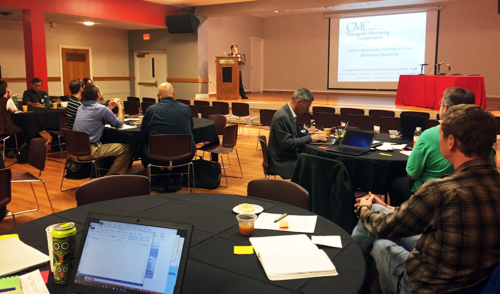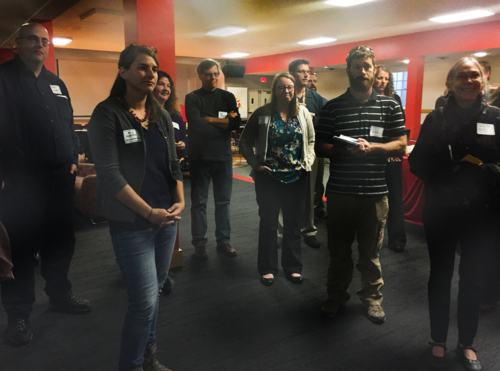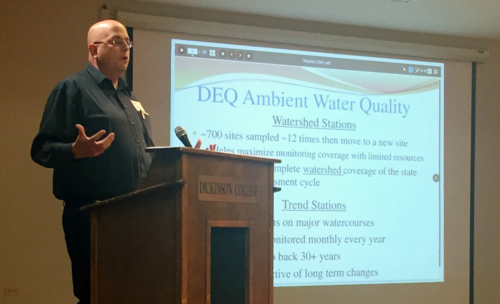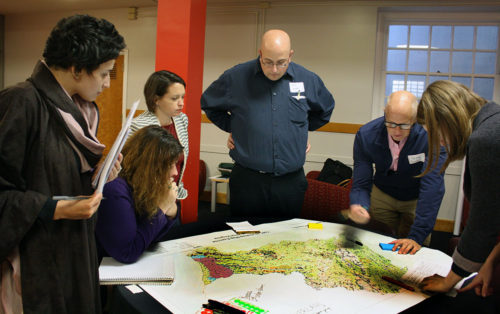Pursuing prioritization in Pennsylvania: The magic of more monitoring
Alexandra Fries ·On October 13th, Caroline Donovan and I traveled to Dickinson College in Carlisle, PA for the Prioritization Workshop. This workshop was held as part of the Chesapeake Monitoring Cooperative (CMC) project that UMCES is a partner of as well as Alliance for the Chesapeake Bay, Izaak Walton League of America, and the Alliance for Aquatic Resource Monitoring (ALLARM). The workshop was hosted by ALLARM at Dickinson College. This workshop included participants from federal, state, and local agencies as well as nontraditional and volunteer monitoring groups and service providers.

There were three main objectives for the workshop.
- Overview of the CMC project and goals and the state’s role in making the project a success.
- Discuss the states needs for more data, at higher frequencies, and how the Cooperative intends to help meet agencies goals for monitoring in the Chesapeake Bay Watershed.
- Collaborate with states and volunteer monitoring organizations to build a stronger, more robust monitoring network for the Chesapeake Bay Watershed.
The workshop began with Rich Batiuk, the Associate Director for Science, Analysis and Implementation at the Chesapeake Bay Program, who gave an introduction on nontraditional monitoring and why it is so valuable to state and federal agencies. He stressed the need to incorporate nontraditional and volunteer monitoring data with state data to improve the coverage of the entire Chesapeake Bay watershed for better decision-making and management actions.

Next, all the members of the Chesapeake Monitoring Cooperative introduced themselves and gave a brief background on the project, including discussing outcomes and tools that would be developed for nontraditional monitoring groups and the states.

Before lunch we had an interactive brainstorming activity where we asked everyone to answer three questions on sticky notes, which we posted around the room. The questions were:
- How is your organization currently using volunteer and/or nontraditional data?
- What are new ways for your organization to use volunteer data?
- What do you need to know about data before you can use it?
This activity gave us some insights such as that some groups are already using data in ways that other groups want to use it in the future (eg. report cards, state reporting, hotspot identification). Some ways people want to use data in the future, that few groups mentioned they are currently doing were for trends analysis, restoration monitoring, and to fill data gaps. Overall, before groups can use the data they want to know the temporal and spatial scale, methodology, quality assurance procedures, and calibration/equipment being used.

After lunch, James Beckley from Virginia Department of Environmental Quality (DEQ) spoke about the success Virginia has had with incorporating volunteer and nontraditional monitoring into state datasets. The interesting thing about Virginia, is they were able to have a law codified so that they could have support in using nontraditional data. Some participants echoed that it would be good to have a similar law in other Bay Watershed states.

The remainder of the day, the participants broke out into groups representing the states they work in, and used large maps to prioritize where they need more data, which indicators they need more data, and examined which groups are already monitoring where. The CMC conducted a census of nontraditional monitoring, and included census results in the map. If you are part of a nontraditional monitoring program and you haven’t filled out the census, you can do so here.

While not all states were fully represented (New York, West Virginia, and DC especially) the participants went through maps of the entire Chesapeake Bay Watershed to come up with where they would prioritize additional monitoring. The results of the mapping exercise and of the meeting will be summarized in a Prioritization Report.

About the author
Alexandra Fries

Alexandra is a Program Manager at the Integration and Application Network (IAN) based at the University of Maryland Center for Environmental Science in Annapolis MD. Alexandra’s work in environmental management has been focused on assessment, monitoring, and management of aquatic, marine, and terrestrial ecosystems. Alexandra has extensive experience in data analysis, synthesis, mapping, interpretation, and communication. Alexandra has experience working with a diverse group of partners including those in local, state, and federal government, non-governmental organizations, non-profit organizations, private industry, and academia. Within IAN, Alexandra conducts data analysis, synthesis, and communication by completing environmental report cards, updating the IAN website, and conducting science communication courses. Alexandra also creates science communication materials such as diagrams, posters, presentations, newsletters, and reports using Adobe Creative Suite, Microsoft Office Suite, and ArcGIS. Alexandra has experience managing projects and staff on local and international projects, liaising directly with partners and colleagues, and providing insights on project direction and goals.